Beef and Potato Curry / Mas Kulunga Kari
(1 hour, serves 6)
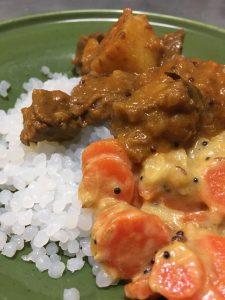
This was my favorite dish growing up, the one my mother always makes for me when I come home, and the first Sri Lankan dish I learned to cook, when I called home desperate from the dorms, begging her to teach me how to make it over the phone. It’s also the first Sri Lankan dish my husband, Kevin, learned to cook — I came home once from a long plane flight, walked into the house, smelled the scent of this curry, that I hadn’t even known he had learned how to make, and promptly burst into tears. Enjoy.
3-5 medium onions, chopped fine
2 TBL ginger, chopped fine
4-5 garlic cloves, sliced
3 TBL vegetable oil
1 tsp black mustard seed
1 tsp cumin seed
1-2 TBL red chili powder
3 lbs chuck steak, cubed, about 1 inch pieces
1/3 cup ketchup
1/4 cup Worcestershire sauce
1 TBL Sri Lankan curry powder
1 heaping tsp salt
3 pieces cinnamon stick
3 cloves
3 cardamom pods
1 dozen curry leaves
1/2 cup milk
3 medium russet potatoes, cut into large chunks
2-3 TBL lime juice
1. In a large pot, sauté onions, ginger, and garlic in oil on medium-high with mustard seed and cumin seeds until onions are golden/translucent (not brown), stirring as needed. Add chili powder and cook 1 minute, stirring. Immediately stir in ketchup, Worcestershire sauce, curry powder, salt, cinnamon, cardamom, cloves, and curry leaves.
2. Add beef and stir on high for a minute or two, browning the meat. Add milk, stirring. Cover, turn down to medium, and let cook half an hour, stirring occasionally.

3. Add potatoes, stir well, and cover again. Cook until potatoes are cooked through, adding water if needed to maintain a nice thick sauce (and to keep food from burning), stirring occasionally. Add lime juice; stir until well blended. Serve hot with rice or bread.
 Okay, this is slightly tricky, since you need to cook it in two batches, but a) tasty, b) nutritious, and c) pretty! I cooked a mix of red rice and quinoa in the rice cooker (on the brown rice setting, which is very slow, so allow extra time). And then cooked some short-grain white rice also in the rice cooker (faster). And then mixed them all together. Yum!
Okay, this is slightly tricky, since you need to cook it in two batches, but a) tasty, b) nutritious, and c) pretty! I cooked a mix of red rice and quinoa in the rice cooker (on the brown rice setting, which is very slow, so allow extra time). And then cooked some short-grain white rice also in the rice cooker (faster). And then mixed them all together. Yum!
 This was a fun one for me — an entirely vegan dinner, that I did for last week’s board game night. Pretty easy with Sri Lankan food. Going around clockwise: lentils in coconut milk (tons of protein), carrot in coconut milk, kale sambol, coconut sambol (spicy), seeni sambol (spicy and sweet), eggplant curried in coconut milk, with red rice / quinoa in the center.
This was a fun one for me — an entirely vegan dinner, that I did for last week’s board game night. Pretty easy with Sri Lankan food. Going around clockwise: lentils in coconut milk (tons of protein), carrot in coconut milk, kale sambol, coconut sambol (spicy), seeni sambol (spicy and sweet), eggplant curried in coconut milk, with red rice / quinoa in the center. (30 minutes draining time + 30 minutes, serves 6)
(30 minutes draining time + 30 minutes, serves 6)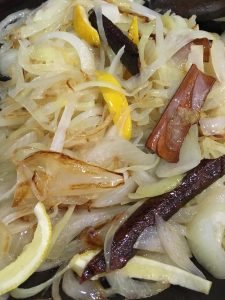 (60 minutes, serves six)
(60 minutes, serves six)
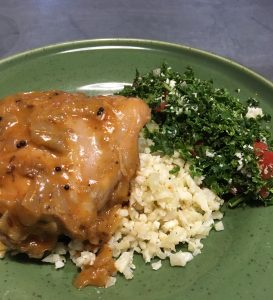
 Experimenting with tofu shirataki noodles (shirataki is made of yam, and is extremely low-carb, low-calorie, and gluten-free); here I added them to a simple Thai yellow curry.
Experimenting with tofu shirataki noodles (shirataki is made of yam, and is extremely low-carb, low-calorie, and gluten-free); here I added them to a simple Thai yellow curry.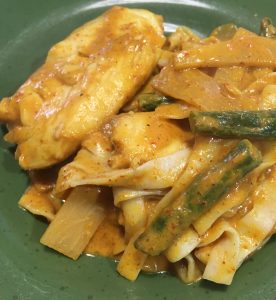


 (20 minutes, serves 4)
(20 minutes, serves 4)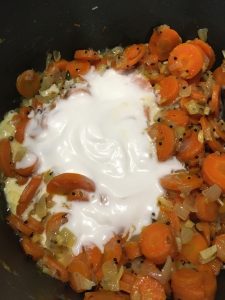
 This may be the most iconic flavor combo of my childhood — beef curry with carrot curry on rice. I think my mom made it close to weekly, and the two flavors go perfectly together — the savory spice of the beef with the sweetness of the carrots cooked in coconut milk.
This may be the most iconic flavor combo of my childhood — beef curry with carrot curry on rice. I think my mom made it close to weekly, and the two flavors go perfectly together — the savory spice of the beef with the sweetness of the carrots cooked in coconut milk. Five minute dinner — well, mostly because of leftovers and accompaniments. I had some rice + quinoa leftover from yesterday, and a little kale salad, and of course, I try to keep myself stocked with coconut sambol and seeni sambol in jars in the fridge.
Five minute dinner — well, mostly because of leftovers and accompaniments. I had some rice + quinoa leftover from yesterday, and a little kale salad, and of course, I try to keep myself stocked with coconut sambol and seeni sambol in jars in the fridge.